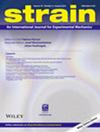Biaxial expansion due to compression experiments for measuring the failure strain of tubular samples
IF 2.4
3区 材料科学
Q2 MATERIALS SCIENCE, CHARACTERIZATION & TESTING
引用次数: 0
Abstract
The failure strain of a tube is a function of the biaxial strain ratio (axial strain/hoop strain) to which it is subjected. The relationship between failure strain and the strain ratio can be determined experimentally using expansion due to compression tests with a tensile load (EDCT), in which a ductile pellet placed inside the tube is compressed axially so it expands in diameter and imposes a hoop strain on the tube. At the same time, a tensile load on the ends of the tube creates an axial strain. This study investigates the capabilities and limitations of EDCT tests using two devices that allow experiments to be performed on a standard tensile testing machine. The first device applies an axial force on the ends of the sample, and the second device applies an axial displacement. Tests on zirconium alloy tubes confirmed that the failure strain is dependent on the strain ratio and the metallurgical state of the material. EDCT tests can produce a range of strain ratios, but there is an upper limit on the strain ratio that can be obtained, and it is dependent on the plastic behaviour of the sample and the friction conditions between the components.测量管状样品破坏应变的压缩双轴膨胀实验
管的失效应变是其所承受的双轴应变比(轴向应变/环向应变)的函数。失效应变和应变率之间的关系可以通过实验确定,使用拉伸载荷(EDCT)的压缩试验引起的膨胀,其中放置在管内的韧性颗粒被轴向压缩,因此其直径膨胀,并在管上施加环向应变。同时,管端的拉伸载荷会产生轴向应变。本研究调查了使用两种设备进行EDCT测试的能力和局限性,这两种设备允许在标准拉伸测试机上进行实验。第一装置在样品的端部上施加轴向力,第二装置施加轴向位移。对锆合金管的试验证实,失效应变取决于应变率和材料的冶金状态。EDCT测试可以产生一系列的应变比,但可以获得的应变比有上限,它取决于样品的塑性行为和部件之间的摩擦条件。
本文章由计算机程序翻译,如有差异,请以英文原文为准。
求助全文
约1分钟内获得全文
求助全文
来源期刊

Strain
工程技术-材料科学:表征与测试
CiteScore
4.10
自引率
4.80%
发文量
27
期刊介绍:
Strain is an international journal that contains contributions from leading-edge research on the measurement of the mechanical behaviour of structures and systems. Strain only accepts contributions with sufficient novelty in the design, implementation, and/or validation of experimental methodologies to characterize materials, structures, and systems; i.e. contributions that are limited to the application of established methodologies are outside of the scope of the journal. The journal includes papers from all engineering disciplines that deal with material behaviour and degradation under load, structural design and measurement techniques. Although the thrust of the journal is experimental, numerical simulations and validation are included in the coverage.
Strain welcomes papers that deal with novel work in the following areas:
experimental techniques
non-destructive evaluation techniques
numerical analysis, simulation and validation
residual stress measurement techniques
design of composite structures and components
impact behaviour of materials and structures
signal and image processing
transducer and sensor design
structural health monitoring
biomechanics
extreme environment
micro- and nano-scale testing method.
 求助内容:
求助内容: 应助结果提醒方式:
应助结果提醒方式:


